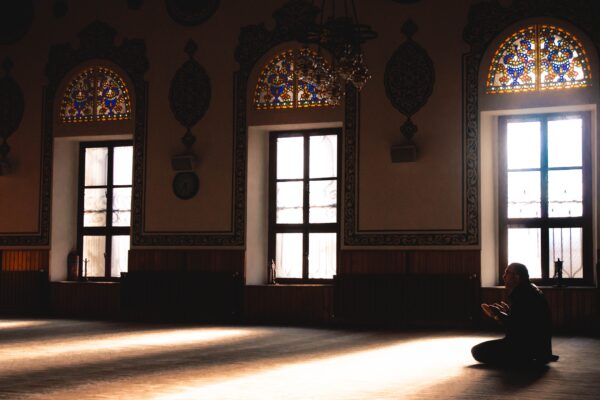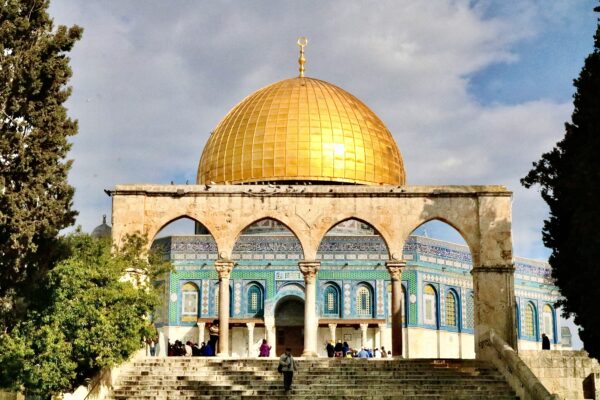Understanding the Quranic meaning of soul mates and being created in pairs.
Understanding the Quranic meaning of soul mates and being created in pairs.
“O humankind, have consciousness of your Loving-Sustainer,[1] who created you from a single nafs (soul) and created from it her zawj (mate) and dispersed from both many men and women. And have God Consciousness, through whom you ask one another, and the wombs. Indeed, God is ever, over you, an Observer.” – The Quran, Meaning of al-Nisaa, The Women [4:1].
Just like letters that go together in a word, there are soulmates who came in the symbolic “Be.” Spiritual partnerships found in soulmates are far from foreign to Islam: on the contrary, The Quran and the Prophetic tradition are replete with them. The need for heart-based self-study and self-discovery beyond (including but not limited to) family of origin, in the Muslim meta-history, is evident in the erasure of this truth from the mainstream narrative. When applied with intellect revelation stands well on its own for depth in understanding relationships. Guidance from the Quran and Prophetic Tradition make connections to the perennial wisdom of all faiths, the spirituality of the Prophetic inclination to love [2] and the Divine Reality of simply being.
Origins of the Modern Concept of Soulmates
The Zohar, a Medieval Jewish compilation deeply rooted in Talmudic tradition relates “Each soul and spirit prior to its entering into this world, consist[ing] of a male and female united into one being.”[3] The Gospel describes this “two in one” relationship as a means to the Kingdom of God with “when you make the inner like the outer and the outer like the inner, and the upper like the lower, and when you make male and female into a single one.”[4]
Current Western conceptions of soulmates popularise the Yin and Yang of Taoism or ancient Chinese Philosophy Shiva and Parvati of Hinduism mention Ardhanarishvara, a “represent[ation of] a synthesis of masculine and feminine energies of the universe,“[5] and Aristotle’s saying “Love is composed of a single soul inhabiting two bodies” [6] are also prominent modern depictions of soulmates. The Quran and Prophetic Tradition, however, is full of context for soulmates by the mere meaning of the term zawj (Quran 4:1, 6:98, 7:189, 39:6). Yet when discussing the soul Seyyed Hossein Nasr discusses how we don’t typically see the connection made by mufaseereen between the first soul being linguistically feminine plural [7] and the pair being masculine (The Study Qur’an, al- Nisaa The Women 4:1).
The Reality of Soulmates in The Primordial Religion [8]
On a metahistorical moment cited as The Day of Alast, it is said “When your Loving-Sustainer took from the children of Adam – from their loins – their descendants and made them testify of themselves, [saying to them], “Am I not your Loving-Sustainer?” They said, “Yes, we have testified.” [This] – lest you should say on the Day of Resurrection, “Indeed, we were of this unaware” (Quran, al- Araf, The Heights 7:172). This is cited as the basis for the mithaq, or Divine covenant with man and the kindred nature of some souls to others. Indeed, this verse has been used alongside The Prophetic Tradition translating to:
“The souls are (like) aligned soldiers joined (in the world of spirits) whichever souls knew each other (in that world) are attracted towards each other (in this world)”
Sahih al-Bukhaari, Kitaab Ahaadeeth al-Anbiyaa’
To substantiate the levels of affinity people experience for one another in this world. Moreover, this is the premise for the ever-present knowledge of a higher being, and thus the fitra, or natural dispositions of humans toward The Highest Unity, God. In our case, specifically, this inclination manifests in the yearning for union and procreation.[10]
The mithaq that not even mountains would take (The Qur’an al Ahzab The Combined Forces 33:72) refers to the Din [11]and more so viceregency. We also see reference to humans as the khalifah or representative of The Divine on earth (The Quran Baqara The Cow 2:30). This centrality of the primordial spirit of humans is crucial to our understanding of soulmates when we understand that the term al Mumin[12] is both a name of God and epistemologically used to describe the second dimension of the Din, Iman.[13] All believers are designated to be soulmates in this sense, and our obligation to fulfil this weighty covenant is reciprocal to our receptivity[14] to this inner truth.
The Experience of Soulmates
We come to know ourselves through trials. Le Gai Eaton in Man captures this in his commentary:
They ‘fell’ together, equal in guilt as they had been equal in glory. Eve was no temptress so far as the Islamic tradition is concerned. And although they were exiled, as were all who lie upon this earth, they were promised by Him Who is named the Ever-Forgiving, the Effacer of sins, that their posterity would never be left without guidance through the dark alleyways of the lower world. This “guidance,” per Islam, culminated and was completed in the coming of Muhammad, who, as it were, closes the circle.[15]
Muhammad’s ﷺ soul and being are still centred as the ultimate example and manifestation of all the Divine Names [16], a perfect balance of the masculine and feminine. Through this, we see that while the latter is an essential category in the cosmology of Islam, they are not stagnant in the sense of being biologically designated as male or female. Indeed, while we also find a polarity existing between the more Jalal, rigorous and Jamaal beautiful attributes we also find they are not confined to relationships of the romantic sense. [17] While polarity underlies the scheme of creation, and all animate creation has azwaj, only humans have access to an Nafas al Rahman, The Spirit of Compassion from The Divine. In this way, we see why despite all the public events, the focus with The Messenger of God ﷺ in Prophetic tradition is on his relationships with the animate and inanimate alike, and most of all The Creator of them all.
God has no need for an intermediary or a method, nor is it fitting, but that does not eliminate the phenomenon of our purpose as khalifahs and the perfection of love God expressed when we were created with God saying Kun fiya kun “be and it is” [1] (Quran Baqara The Cow 2:117). For God, there is “Nothing like it” and “nothing like its likeness” (Quran Ash Shuraa The Consultation 42:11).[18] In this way, we recognize human life as a love letter in the symbolic, linguistic sense, and ontologically as a state of being. We are all a few letters away from Pure Being, God as itself. Just like letters that go together in a word, there are soulmates who came in symbolic “Be.”
The Primary Longing for Unity
Separation from The Absolute is impossible. Le Gai Eaton elaborates on this wisdom with “Reality, which is also by definition absolute Perfection, can only have one obligation, the obligation to be Itself.[19] Thus the reality of all, even mates, originates from one soul and ultimately God itself. In truly realizing this The Absolute Reality of individual experience is delivered from the caprice of false identity and to Wahdat al Wujud, or Oneness of Being, substantiating the sages who say “the one who knows themselves knows their Loving-Sustainer.” This is the meaning of the original question God posed “Am I not your Loving-Sustainer?” Our response is a core level testimony to the Unity we long for in every way. Answering for one’s self is to answer their soulmate, only a letter or so from them, and in truth only one in number and nature. Through it all, we come to know that even when it seems we aren’t physically with certain beings they undeniably appear in the forms of others we meet, and at high levels are integrated into our very heartbeat.
Sources:
- Ali, Abdullah Yusuf. The Meaning of the Holy Quran. Amana Pubns, 2004.
- Bayrak, Tosun, and Rabia Terri Harris. “What the Seeker Needs.” (1992).
- Bolton, Robert. “Aristotle’s Definitions of the Soul:” De Anima” ii, 1-3.” Phronesis (1978): 258-278.
- Brown, Raymond Edward. The Gospel According to John. Vol. 29. verse 22. Cambridge University Press, 1970.
- Driver, Samuel Rolles. The book of Genesis. Vol. 1. Methuen, 1904.
- Gottwald, Norman Karol. The Hebrew Bible–a socio-literary introduction. Fortress Pr, 1985.
- Haviland, William; Prins, Harald; Walrath, Dana; McBride, Bunny, Anthropology: The Human Challenge Fifteen Edition. Cengage Learning, 2016, pg 561
- Le Gai Eaton, Charles. “Islam and the Destiny of Man.” Albany: State University of New York (1985).
- Nasr, Seyyed Hossein, Caner K. Dagli, Maria Massi Dakake, Joseph EB Lumbard, and Mohammed Rustom. “The Study Quran.” (2015).
- Sunnah.com retrieved April 19th, 2017.
- Ware III, Rudolph T. The Walking Qur’an: Islamic education, embodied knowledge, and history in West Africa. UNC Press Books, 2014.
- Wehr, Hans, and J. Milton Cowan. A Dictionary of Modern Written Arabic:(Arab.-Engl.). Otto Harrassowitz Verlag, 1979.
- “Rabb” based on the intimate connotations of what is commonly translated “Lord.”
- See God as Love and Light in God by Seyyed Hossein Nasr for full commentary on this.
- [3] Matt, Daniel Chanan. Zohar: Annotated & Explained. Skylight Paths Publishing, (2002) 31. Also “Then God separated from Adam another Adam as a helpmate (Genesis 2:2-22; Genesis 5:2).
- [4] Thomas Gospel 22.
- [5] Haviland, William; Prins, Harald; Walrath, Dana; McBride, Bunny, Anthropology: The Human Challenge Fifteen Edition. Cengage Learning, 2016, pg 561
- [6] Bolton, Robert. “Aristotle’s Definitions of the Soul:” De Anima” ii, 1-3.” Phronesis (1978): 258-278.
- [7] Nafs is a linguistically feminine.
- [8] Din al Fitra
- [9] Sahih al-Bukhaari, Kitaab Ahaadeeth al-Anbiyaa’.
- [10] Or per the theological minority of Maturidis at least the blank slate waiting to be filled as some distinguish which still implies Godliness since there is only one overwhelming Truth.
- [11] Commonly translated religion, or faith, specifically breaks down to disposition, Debtor and indebtedness and the essence of civilization, or madina. See the-concept-of-religion-by-sayyid-naquib-al-attas for an in-depth discussion of this.
- [12] Believer
- [13] Faith
- [14] Le Gai Eaton, Charles. “Islam and the Destiny of Man.” Albany: State University of New York (1985) (365).
- [15] Le Gai Eaton, Charles. “Islam and the Destiny of Man.” Albany: State University of New York (1985) (361).
- [16] “al- Asma al Husna” Qur’an Hashir 59:24.
- [17] I.e. they can be Platonic as in a relationship with student and teacher, family, friends etc.
- [18] Quran Ash Shuraa The Consultation (42:11)
- [19] Le Gai Eaton, Charles. “Islam and the Destiny of Man.” Albany: State University of New York (1985) (361).
by Maryam Miller





